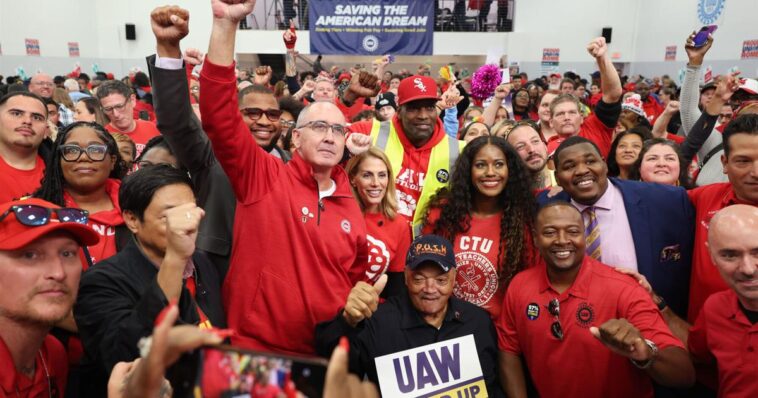Ford UAW Agreement Analysis
Breaking Down the Ford UAW Agreement: What You Need to Know
Ford UAW Agreement Analysis: The United Auto Workers' historic tentative agreement with Ford Motor Co. secures significant gains towards recovering concessions made during the automotive bankruptcies and Great Recession.
Ford UAW Agreement Analysis: A Paradigm Shift in the Auto Industry
In a remarkable turn of events, the United Auto Workers (UAW) have achieved what they set out to do – reclaim lost ground. The tentative agreement between the UAW and Ford Motor Co. represents a significant stride towards the union's goal of regaining concessions made during the turbulent times of automotive bankruptcies and the Great Recession. This monumental deal, set to endure until April 2028, secures double-digit wage increases, raises starting pay, reintroduces cost-of-living adjustments, shortens the timeline to reach top wages, and boosts retirement contributions. The UAW's Ford council is expected to vote on this transformative agreement, which could impact the lives of roughly 56,000 members employed by the Blue Oval, setting the tone for the future of labor negotiations.
The pivotal point to note is that autoworkers' wages have struggled to keep pace with inflation. This critical issue, one that the union has been emphatically underscoring, has been acknowledged even by the automakers themselves. During previous rounds of negotiations aimed at helping the automakers survive, the UAW had to relinquish the cost-of-living adjustments (COLA), introduce an eight-year timeline to reach top wages, and abandon traditional pensions and retirement health care coverage in favor of 401(k)s for employees hired after 2007.
The workers, however, have made it clear that they are determined to reclaim these lost benefits and believe they deserve nothing less. They firmly stand behind the demand for the reinstatement of these essential components. It's a part of the larger struggle to restore economic balance and dignity to the workforce. The battle for COLA, in particular, has been long and arduous. But these fighters believe that reinstating COLA is not just about monetary compensation; it's about building the foundation for a stronger economy.
Brittany Eason, a 12-year UAW member, expressed her hopes that this tentative agreement would enable her to give up her side gig with Instacart and expedite her plans of starting a food business. The power of these negotiations isn't merely about higher wages; it's about realizing personal dreams, aspirations, and financial stability for the hardworking members of the UAW.
It's important to note that the UAW President, Shawn Fain, recognized that the union wouldn't be able to achieve all its goals in a single round of negotiations. This is a reality reflected in the Ford deal. Despite not achieving everything they wanted, this agreement contains more value for the members in each individual year of its duration than the entire 2019 agreement. The UAW's stand-up strike, which lasted a historic 41 days and made this negotiation possible, has delivered tangible results.
In a scenario marked by years of robust profits, an employment rate below 4%, escalating inflation, and the ongoing transition to electric vehicles (EVs), these labor negotiations unfolded in a complex environment. The backdrop of uncertainty related to EV production and demand has added to the intricacy of these talks. Some of the automakers have already revised their EV production plans, which raises concerns about the future profitability of the EV market. The question arises: will they still be in a favorable position four years from now to negotiate a favorable deal? These uncertainties underscore the significance of the current agreement.
When the UAW announced the deal with Ford, it was already the 41st day of its simultaneous strike against the Detroit Three. For Ford, the strike had disrupted operations at several of its plants. The union's strategic move of keeping the strike going even after the agreement's announcement was a clear message to General Motors Co. and Stellantis NV: the UAW is unyielding in its commitment to its members' welfare.
The details of the agreement remain confidential, but Ford has expressed its contentment with reaching this deal. It's working diligently to bring its 20,000 affected employees back to work, ensuring that the impact of the strike is minimized. The UAW, on the other hand, has made headway in bargaining for several concessions that had been given up in the past. Health care coverage for full-time workers hired after 2007 now aligns with that of legacy workers. Lost holiday and legal aid benefits have also been restored. These achievements are part of a continuous effort to bolster workers' benefits.
The aspiration to extend pensions and health care coverage in retirement to all autoworkers, including those hired after 2007, was not realized. This request alone would have entailed significant costs for the automakers, running into billions of dollars. Ford, however, did make improvements for current retirees, workers with pensions, and those with 401(k) plans. The balance struck in this regard demonstrates the automaker's commitment to its workforce while also considering the broader economic context.
The union's demand to reinstate the jobs bank, a policy criticized during the bankruptcies of General Motors Corp. and Chrysler LLC, was not met. However, the UAW did gain the right to strike over plant closures for the first time. While Ford has committed to product allocation at all its U.S. plants, the ability to strike over plant closures empowers the union with a crucial tool to protect workers' interests.
The return of COLA to its 2009 status and the reduction of the timeline to reach the top wage to three years, as it was until 2007, demonstrate that the UAW achieved some of its key objectives. The reduction of the timeline from eight years to three represents a significant improvement for newer workers. Although the union initially sought a 90-day timeline, the agreement marks a substantial step in the right direction, ensuring that workers can reach top wages sooner.
However, the year 2023 brings unique challenges to the negotiation table. The union is advocating for new electric-vehicle battery plants' inclusion in the master agreement with the automakers, ensuring that workers at these facilities receive pay, benefits, and protections on par with their counterparts in assembly and powertrain plants. General Motors has signaled its willingness to include Ultium Cells LLC battery plant workers in its master agreement, but the specifics of this arrangement are yet to be disclosed. Ford, with no operational battery plant as yet, poses a different challenge.
The UAW's demands extend beyond what they've ever asked for before. While they withdrew their request for a 32-hour workweek, it's important to recognize that the discussion of such a proposal dates back to the 1970s, showcasing the union's long-standing commitment to workers' well-being.
This agreement holds the promise of making a substantial impact on autoworker wages. Ford has agreed to a 25% wage increase, not compounded, through April 2028. When combined with COLA, this translates to a substantial rise in top production pay, eclipsing $40 per hour from the current $32.32. An immediate 11% wage hike upon ratification signifies a significant boost, pushing the maximum rate to about $35.87. The 2019 contract, in contrast, offered autoworkers 3% raises in two years and 4% lump sums in the other two, coupled with a $9,000 signing bonus for full-time workers.
The original UAW request for a 46% compounded wage increase (40% not compounded) would have been transformative, raising the maximum wage to $47.14 per hour by the end of 2027. The impact of such an increase would have far-reaching consequences for the livelihoods of autoworkers.
The significance of this agreement becomes even more apparent when viewed against the backdrop of history. In the 1980s and 1990s, autoworkers were accustomed to annual wage increases of 2.25% to 3% or lump-sum bonuses of a similar magnitude. However, the 2003 contract marked the first time a two-year base wage freeze was introduced, followed by a four-year wage freeze in the 2007 contract, which also brought in the concept of “the second tier.” Workers hired after ratification began with wages approximately half of their legacy counterparts, without pensions, retirement health care coverage, or similar health benefits. A comparison with the past reveals that even with the immediate raise offered in this new agreement, top wage earners will still have less purchasing power than they had four years ago.
This deal signifies a pivotal moment for autoworkers, not just in terms of wages, but also in terms of comprehensive compensation. With some of the most robust health care coverage in the country, coupled with substantial profit-sharing and bonuses, wages represent just one part of the overall compensation picture.
Looking at the broader perspective, a 25% wage increase at Ford brings the UAW closer to achieving a goal: surpassing the compensation increase of the CEO over the past four years. The UAW has justified its original request for a 40% not-compounded wage hike by drawing attention to a 40% average increase in CEO compensation across the Detroit Three since 2019. This argument highlights the vast gap in compensation between workers and top executives.
This stark contrast between the workers' struggle for reasonable wage increases and the escalating salaries of CEOs is a critical issue that demands attention. CEO compensation, not only in the automotive industry but across various sectors, has skyrocketed over the years. A recent report indicated that CEO pay has risen dramatically, with CEOs now earning 344 times the salary of the average worker. This figure is a far cry from the situation in 1965 when CEOs were paid only 21 times as much as the typical worker. The persistently widening pay gap between executives and employees raises concerns about wealth distribution and income inequality.
While it's true that the CEO role is distinctly different from rank-and-file positions, companies must be transparent about their ability to compensate top executives while also ensuring fair remuneration for their workforce. These increasing CEO-to-average-worker pay ratios suggest that there is an abundance of wealth within these corporations. Ford CEO Jim Farley's compensation of $21 million last year, and GM CEO Mary Barra's $28.97 million, are not just generous rewards but are also reflective of a growing trend. These numbers are substantially higher when adjusted for inflation, underscoring the soaring compensation packages of today's CEOs.
Stellantis, formed by the merger of Fiat Chrysler Automobiles and Groupe PSA, stands as a testament to this trend. Stellantis CEO Carlos Tavares received a compensation package of $24.8 million last year, which represents a 72% increase compared to his predecessor's package in 2019. While the company points to a performance-based compensation structure, the widening gap between executive salaries and worker wages continues to be a subject of concern.
In comparison, UAW President Shawn Fain's compensation, which is set according to the union's constitution, falls within the top 10% of U.S. household incomes. The recent 3% increase, approved by the delegates for the international executive board members, has brought his total compensation closer to that of the Detroit Three CEOs, but still notably lower. This contrast serves as a stark reminder of the disparity in income distribution and the power imbalance within the corporate world.
In 2007, Ford CEO Alan Mulally's compensation, adjusted for inflation, exceeded the current CEOs, Jim Farley and Mary Barra, when he received $21.67 million. This historical perspective underscores the evolving landscape of executive pay in the automotive industry. It also prompts a broader conversation about the principles of fair compensation and income equity.
The UAW-Ford agreement is a monumental milestone in the ongoing saga of labor negotiations in the automotive industry. It is a testament to the determination of autoworkers to secure a brighter future for themselves and their families. The struggle for fair wages and improved working conditions has not been without challenges, but it stands as a symbol of resilience and unity.
As we move forward, the discussion around compensation structures in the corporate world should not be confined to the boardroom. It is a matter that concerns all members of society. The question of how we reward top executives while ensuring that the workforce is not left behind remains a pressing issue. The UAW-Ford agreement may serve as a catalyst for broader conversations about income distribution, wealth equality, and the changing dynamics of the automotive industry.
In conclusion, the UAW's tireless efforts have borne fruit with the historic Ford agreement. This transformational deal signifies a turning point in the automotive industry, a moment of reckoning for the disparity between executive compensation and worker wages. It's not just about numbers; it's about equity and the well-being of individuals who form the backbone of these corporations. The UAW has spoken, and it's time for the world to listen and reflect on the future we want to build together.
Join the Conversation
What are your thoughts on the UAW-Ford agreement and the disparity in CEO compensation? How do you see the future of labor negotiations and income distribution in the corporate world? Share your insights and opinions in the comments section below. Let's engage in a meaningful conversation about these critical issues.
This article was written by the NewsBurrow Press Team.
In the midst of significant developments surrounding the UAW's tentative agreement with Ford Motor Co., it becomes evident that a new chapter is unfolding for autoworkers and the automotive industry. As we explore the intricacies of this historic deal aimed at rectifying past concessions and ushering in a brighter future, we must remember that every milestone achieved is a testament to the resilience and determination of the American workforce.
The agreement, set to span until April 2028, promises double-digit wage increases, revived cost-of-living adjustments, and an expedited path to higher wages. It's a beacon of hope for autoworkers who, in previous negotiations, saw their sacrifices help companies survive while their own benefits dwindled. Now, as the United Auto Workers continue to push for what's rightfully theirs, it's a time for reflection and celebration of the gains made so far.
In the next section, we'll delve into the affiliate products that can complement these developments, ensuring that autoworkers, their families, and all readers are well-equipped for the journey ahead. Stay with us as we explore how these products can enhance your life and experience in these transformative times.
Shop Products On Amazon
Products From Amazon
Shop Products on Ebay
Trending Similar Stories in the News
UAW strike could be nearing end as union is reportedly close to deal with Ford - FOX 2 Detroit
October 25, 2023 - FOX 2 DetroitUAW strike could be nearing end as union is reportedly close to deal with Ford FOX 2 Detroit...
Cox Automotive Analysis: Ford Motor Company's Q3 2023 U.S. ... - Cox Automotive
October 25, 2023 - Cox AutomotiveCox Automotive Analysis: Ford Motor Company's Q3 2023 U.S. Cox Automotive...
Trending Videos of Ford UAW Agreement Analysis
UAW Moves Closer to Deal With Ford: AP
The UAW appears to be moving closer to a tentative contract agreement with Ford, the Associated Press reports, citing two ...
Ford, UAW reach tentative deal to end labor strikes
CNBC's Phil LeBeau joins 'Squawk Box' with the latest developments on the UAW strike. For access to live and exclusive video ...
Breaking Down the Ford UAW Agreement: What You Need to Know
Similar Posts, Popular Now
India 6G program
Hells Angels Clubhouses For Sale
NHS Surgery Wait Times
New Speaker Mike Johnson
Rugby World Cup 2023 Final Result









![Breaking Down The Ford Uaw Agreement: What You Need To Know 14 Maisto 1:25 Scale 1948 Ford F-1 Pickup Diecast Truck Vehicle, Colors May Vary [Grey/Blue]](https://m.media-amazon.com/images/I/61gbo2P2p4L._SS520_.jpg)















GIPHY App Key not set. Please check settings